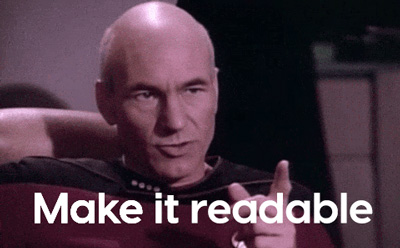Every brand needs to be trusted and content marketing is the way to do it. When executed well, it will give your brand a personality that customers want to engage with. When content misses the mark, you’ll waste time, money and opportunities for growth.
As we’ve grown Readable, our content has always been at the core of what we do as a company. And that’s not just because we’re in the business of communication.
Content gives us the opportunity to showcase our core values in a fun, entertaining and informative way. By doing this we hope you also get to understand our passions and what makes us come into work each day with a smile.
To help you out, I’ve pulled together ten points that have helped us on our way:
- Start with your customer
- Create a content marketing plan
- Don’t just sell, tell a story
- Be original
- Make it readable
- Optimise for conversion
- Use workflows
- Be consistent
- Don’t go live without proofreading first
- Get your message out there
1 | Start with your customer
Your customer is at the center of your world. They are the reason you deliver your product/service. They are the reason you can afford to pay your bills.
So when it comes to your content, customers should be central.
Organizations often confuse content marketing as an excuse to talk about themselves. This can be as straightforward as solely talking about your product/service and its components.
Which means you forget to focus on the “what’s in it for me factor” that every visitor to your website will be looking for.
Providing that answer isn’t just about saying your product is amazing because it has x, y or z. It’s about showing why x, y and z will help your customer.
A good example of this is the promotion of a new product.
Take Speaker Widget Ltd. They are about to launch a new portable speaker called BoomMaster - sounds good, doesn’t it?
They have the choice of two pieces of promotional copy, to be placed above the fold of their homepage.
Option one
On sale now, BoomMaster.
Featuring 86 dBC of sound. 10 Hour battery life. Suitable for smartphones, tablets and Bluetooth devices. Waterproof up to 2m for 15 minutes. Buy now, only $99.
Option two
BoomMaster, $99.
Super portable and super fun Bluetooth speaker, with awesomely big sound. Crystal clear and full of bass. Enjoy BoomMaster's huge sound while on the go, with 10 hours of battery.
There’s a subtle difference between the two pieces of copy. Option one is inwardly facing where the copy tells the reader what BoomMaster does.
All of it is interesting and people will want to know this, but it shouldn’t be the first thing you tell potential customers.
Option two has the customer in mind and their emotions.
Not only does it tell the customer what BoomMaster is capable of, it lets them know how their life will be better with it and why they should buy it. It appeals to its young, and young at heart, target audience.
The second option will convert higher and bring in more sales. Which is why you can forgive the copywriter for using the word awesomely!
When putting the customer first, think of:
- Why is that piece of content of interest to them?
- What are they going to get from the piece of content?
- How the piece of content is going to drive them to take the action you’d like them to. More on this in point six.
2 | Create a content marketing plan
Content marketing without a plan is like walking blindfolded in the dark. It can be done, but you’re likely to get yourself in a mess, not know where you are, and it’s not a lot of fun.
Getting hands on with PostIt notes is a great way to get the creative juices flowing. Throwing ideas up will allow you to see what will stick - every pun intended - and what can be knocked on the head.
When you have your ideas in place, you need to pull them together into a master plan. asana.com is a great option for this and is free to use for small teams.
I use Asana to:
- Put each piece of content into a focussed category
- Create and assign tasks
- Communicate with my team and keep notes
- Schedule when the content is going to be used
- Coordinate content sign off
- Tick off the job, when it’s done <-- Always fun to do!
Content marketing plans always need to be flexible. Stick to it as closely as you can, while knowing that new bits of content could be needed at short notice.
3 | Don’t just sell, tell a story
Storytelling is incredibly powerful. We all enjoy being swept up in a good story.
Not all stories are fictional, which makes content marketing and sales very much part of storytelling. Take people on a journey and show them why you’re a brand they can trust.
Styles of stories can include:
- Personality - Show your customers what you’re all about. You’re more likely to spend money with a company you can associate with and trust.
- Honesty - Not all stories are fiction and the stories you tell about your brand and product should definitely be honest. Don’t oversell yourself.
- Inspiration - What’s the story behind your business? How many hours have you put into building things up from scratch?
- Emotion - A powerful tool. If you can show how your product will change people’s lives, you’re onto a winner. Now, this doesn’t need to be big sweeping changes. It could be as simple as saving customers a few minutes, even seconds, while doing a mundane task.
4 | Be original
There’s no such thing as an original story, but there are new ways to tell a story.
Originality comes from being true to your brand and the reason why you love doing what you do.
Show how you’ve turned your passion into a product/service and why that benefits them. It’s far better to read about why your passionate than another run of the mill blog.
5 | Make it readable
Having clear and easy to understand content is an absolute must. You do this by adopting readability practices, such as:
- Writing copy that is written at the correct reading level
- Avoiding using a large number of long sentences
- Not using complicated wording or too many syllables
- Removing industry buzzwords and jargon. If you have to use them, explain what they mean
It’s definitely not a case of dumbing down content for the sake of it. As one of my favorite readability quotes puts it, “Write for the expert, but write so the non-expert can understand" - Bernard Kilgore.
Based on the Flesch-Kincaid Grade Level, we’ve created a handy visual guide on where your content should sit.
6 | Optimise for conversion
When thinking about content, you're ultimately thinking about what action you’d like the reader to make. Such as:
- Do you want people to visit your website?
- Are you looking for readers to sign up for your newsletter?
- Do you want them to make a purchase?
- Are you aiming to boost brand exposure?
To get this right you have to have the right message, delivered at the right time and in the right format.
This is where workflows are your best friend.
7 | Use workflows
It’ll not be as simple as having only one piece of content - a landing or product page, for example - to make a sale. You’ll need to create a series of content that will move customers through your marketing and sales funnels.
At each stage, you’re giving potential customers the information and content they need to help them make an informed decision. If you lose some people along the way, that’s fine. If you lose a lot, you know your content isn’t working.
Drip marketing tools, such as drip.com or hubspot.com, make this easy to do. Allowing you to keep track of everything, tweak your campaigns through AB tests, and make your content personal to each customer/potential customer.
8 | Be consistent
Deliver content that’s expected of you. If you sell cars, write about electric charging points in major cities and road safety. Don’t deliver content about your local sports team, unless you’re their sponsor.
Keep on message and deliver it at regular intervals. Finding a schedule you can stick to can be hard. You don’t want to overstretch yourself, especially if you are a small team.
9 | Don’t go live without proofreading first
Common sense time, again. The more people that read your copy the better.
10 | Get your message out there.
“Build it and they will come.” No, Kevin Costner, no! You’re talking nonsense. That may work for baseball playing ghosts, but it doesn’t work online.
Get your message out through as many applicable channels as possible. But, make sure the message fits the platform you’re promoting it on. Don’t just carpet bomb everywhere with the same message.
Check out Jab. Jab. Jab. Right hook by Gary Vaynerchuk. It’s a few years old now, but its core message of using native/bespoke content for each social platform is still very relevant.
To sum up
Content marketing can be daunting, but it doesn’t need to be. Tackle it with confidence. Confidence in knowing you're creating the best possible content for your customer.
Clarity of message is the key. If you can achieve this in an honest and positive way, your content will help you grow your business.





